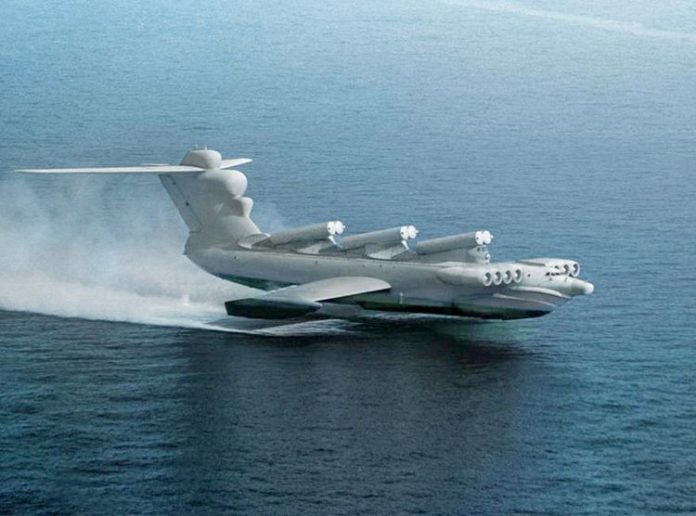
An outside observer this rocking on a lazy wave of Caspian ship seem a gimmick. Or the fruit of the designer's imagination. A long, rapid housing, looks like a fuselage of an airliner, turning into a "dolphin nose" cabin, windscreens where frightening sound like slanted eyes. Turboreaktivnыe engines. Aircraft keel - tail. When this incomprehensible edifice towed to clean water, vzrevut deafening engines and narrow predatory torso jerk forward in a cloud of spray. typing speed, the car will slide out of the water and rush with fighter speed at a height of several meters above the sea swell.
«Our boat was already close to the shore, when the part of the sea became to grow the roar of engines. We saw, that to us is fast approaching strange iron monster - whether the plane, whether the ship. Its dimensions are more and more increased, and we realized, it's still a huge plane, rushing straight at us a few meters above the water. We were confused and numb. When we left to one hundred meters, he, zalozhiv Virage, He began to turn towards the island. It seemed, wing end it is about to crash into the wave. But no - the water under the wing if bent, monster leveled off and continued his move to the land. We saw, it hardly rose above the mound, then fell behind him and, following the topography of the island, It disappeared over the horizon...». On the meeting with Russian fishermen ekranoplan wrote in 1992 year "Technology - Youth".
We consider, that generally represent a WIG, what they are and where they can be used. WIG - What is it? first understand, What is WIG. According to the military encyclopedia, this vehicle- — weapon, the ability to fly at altitudes, equal 0.05 — 0.2 the width of the wing near the water surface, ice or flat land areas using TN. "Screen effect", is the formation of "air cushion", up-lift of its wings.
The magazine "Aviation and Time" ('AeroKhobbi') You can read, ekranoplan is that the aircraft, intended for high-speed near the line between two media, such as air and water. In the book "Shock ships' famous naval expert YV. Apalkov writes, that is winged SHIP, using ground effect (a sharp increase in load-bearing properties of the wing at low altitudes).
According to the design-process device (metal, equipment, engines) and operating conditions (basing, take-off landing, flight) WIG is practically no different from the seaplane. Its specificity is the ability to sustainable priekrannomu regime cruising at altitudes of the order 0-5 m. Flying in this mode allows you to create in 1,5-3 times heavier vehicles with the same area of the wing and engine power. The winged has the ability to self-stabilization adjustment, go and Pitch (trim), that ensures the safety of the flight at extremely low altitudes over the wave crests. The main mode of motion is a steady horizontal flight, in which the pilot control actions are small and are mainly associated with maintaining the most favorable flight conditions at the lowest possible height above the surface.
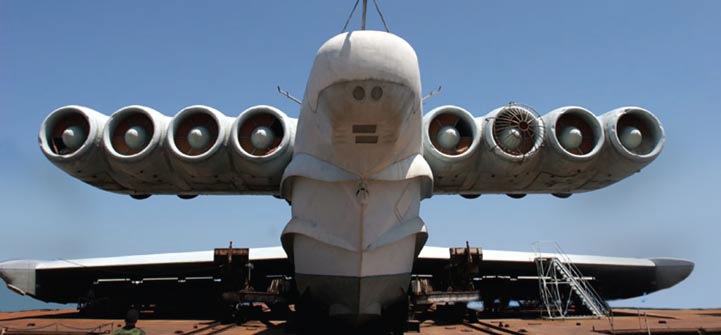
So after all, WIG - a ship or aircraft?
At first, usually WIG, as stated above, Flying at low altitude, to 10-15 m. Based on this, he still is the aircraft, naturally, a particular type, instead SHIP. Although marine scientists have a different opinion - WIG craft is the latest stage of development of the idea of raising the speed of the vessel from the water body (glisser, hydrofoil, hovercraft, WIG).
Secondly, flight at low altitude using ground effect allows to achieve higher payload and fuel economy compared to conventional aircraft and higher speed compared to ships, including hovercraft and hydrofoil. Consequently, in different situations WIG craft can be regarded as a competitor ships, and as a competitor of aircraft and helicopters.
Thirdly, WIG is on the water at take-off, landing, to perform the necessary actions (eg, save people) and in case of possible emergencies. Therefore, the use of ekranoplanes is expected from conventional airfields., as terrestrial, and water (hydro aerodromes), and, perhaps, from ships (small ekranoplanes).
A joint decision of the international aviation and maritime organizations WIG ships are still considered (it was caused by reasons purely traffic management) and are divided into three types:
- type A - ship, which is certified for use only within the "ground effect" area. Such vessels in all operating modes are subject to maritime requirements.;
- type B - ship, which is certified for a short and limited amount to increase altitude beyond the action "ground effect", but at a distance from the surface, not exceeding 150 m (for the flight over the other ship, obstruction or other purposes). It is also subject to maritime claims. The maximum height of such a "trip" should be less than, than the minimum safe flight altitude of the aircraft for airmen requirements (the sea - 150 m);
- type C - ship, certified to operate outside the "ground effect" zone at the height of, exceeding 150 m. It is subject to maritime claims in all operating modes, except for "airplane". In the "airplane" mode, safety is provided only by aviation requirements, taking into account the peculiarities of ekranoplanes.
For example, type A correspond to ekranoplanes G. Jorga - TAF-VIII and others.; Type B - WIG KM, "Eaglet", "Lun", A WIG. Lippisha X-112 - H114, etc.; Type C - draft WIG "Pelican".
History ekranoplanostroeniya
Screen effect was discovered by airmen. They are faced with an unusual behavior of the aircraft on takeoff and landing back in the 20s - at the ground plane suddenly gains extra lift and, instead of, to fly horizontally, I strove to "climb up" or, ignoring management, I did not wish to land. By the early 1930s,. this riddle could reveal - at low altitude air flow as it is clamped between the wing and the ground and, condensing, It creates a dynamic air cushion, dramatically increases the lift of the wing. A phenomenon called the "effect of the influence of the earth", and later - "Screen effect".
One of the first domestic works, on the impact of land on the aerodynamic properties of the wing, It was an experimental work BN. St. George's. During the period 1935-1937 gg. complex experimental and theoretical research in this field conducted YA.M. Serebriysky and SH.A. Biyachuev TsAGI. Around the same period, a number of theoretical studies were carried out by prominent foreign scientists: A. Betcem, TO. Wieelsberg, FROM. Hagget, D. Bagley, M. Finn. The results of these studies have allowed a qualitative assessment of the impact of screen effect on the aerodynamic characteristics of the low-flying wing. In particular, was shown, that the lifting force of the wing grows, and the more, the closer the wing to the ground; and also decreases the resistance varies longitudinal moment.
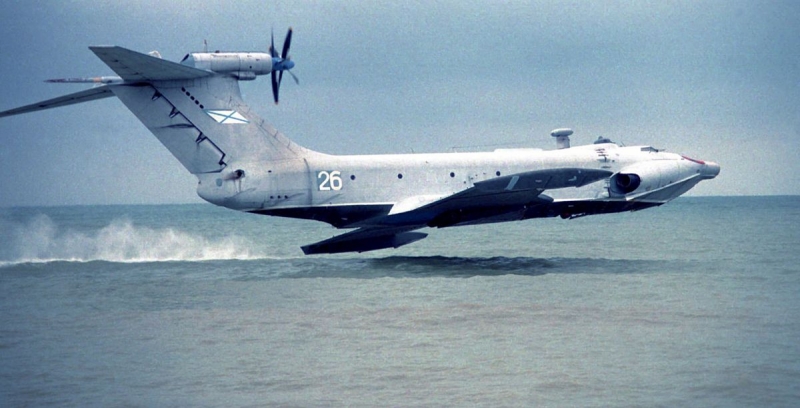
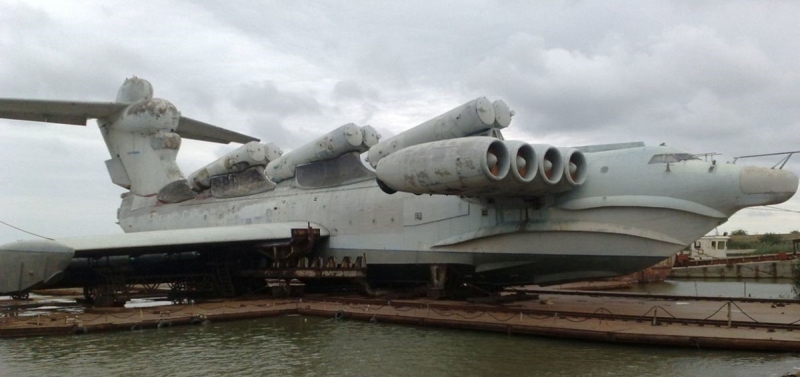 examples WIG: "Eaglet" (up) and "Lun" (at the bottom)
examples WIG: "Eaglet" (up) and "Lun" (at the bottom)
As for the shipbuilding industry, that prior to the beginning of the twentieth century the only means of water transport remained displacement boat, which rarely exceed speed 20-40 km / h because of the sharp increase in the resistance of the wave - a wave barrier. In the early twentieth century were invented ships dynamically supported - speed-boats and hydrofoils (IBS), when the displacement body, fully or partially, supported above the water surface due to the hydrodynamic forces.
The first hydrofoil built in the world 1894 g. French engineer Charles d'Alembert. The boat was unsuccessful, it was not possible to achieve stable motion, but the idea was received with interest: at 1906 g. E. Forlanini built in the US boat, developed speed 40 knots. d'Alembert also built the first self-propelled speedboat, showed a speed of about 20 knots. AT 1935 g. under the guidance of a professor at the Moscow Aviation Institute (MAI) IN AND. Levkova created the world's first hovercraft (SVP) L-1. The very existence of this and subsequent ships, including a record A-5, I was deeply secretive, and the West Levkova evolved independently of its method of calculating the SVP.
As you know, aviation ground effect is "harmful". But that, that does not fit aviators, decided to use shipbuilders. Apparently, the first ekranoplan was created by the Finnish engineer T. Cario. in winter 1932 g. over the frozen surface of the lake, he tested the ekranoplan, aerosled-towed. AT 1939 g. American engineer D. Warner, working on speedboats, He proposed a draft vessel with a system carrier air wings. By request of the military establishment in Sweden extensive work carried out in the 40s and. Troengom. WIG-two cutters were obtained, but the results did not satisfy the customer, and the work turned.
The experience of the Second World War showed the high efficiency of high-speed ships, especially when applied to sudden shock to the opponent and conducting landing operations. After the war, in various countries around the world on the orders of the Navy or the initiative to built small (weighing up 5 t) experimental WIG. Abroad, active attention to ekranoplanes is associated with the publication of the test results of the Kh-112 ekranoplan of the famous German aerodynamics A. Lippisha. Lippisch's scheme is known as the tent-wing scheme., good holding of air pressure between the wing and the screen and having the lowest inductive resistance. The tail is located high above the wing in a T-shaped pattern. For launch from the water, floats at the ends of the wing and a planing hull-boat were used.
Later, in the 70s G. Jorg (FRG) another variant of the scheme stable in near-screen flight is proposed - the "tandem" scheme. It is another version of the basic WIG craft, in which two approximately identical wings are located one after another ("Tandem"). The circuit also has longitudinal stability, but in a limited range of pitch angles and flight altitudes. Since the 60s, several dozen experimental ekranoplanes with a variety of options for aerodynamic schemes and launch and landing devices have been created and tested in various countries..
Work in this direction was successfully progressing in the USSR, which by the 1980s created. the lion's share of those created by that time 25 ekranoplan samples. The Gorky Central Design Bureau of Hydrofoils became the leader of developments, led by R.E. Alekseev (Central Design Bureau for SEC), which built missile-carrying missiles for the USSR Navy under the state order, airborne transport and anti-submarine ekranoplanes. Basic scheme of ekranoplanes R.E.. Alekseeva is characterized as a "normal aircraft configuration" with a low wing of low aspect ratio, equipped with end washers, and high-lying T-shaped tail, maximally removed from the zone of flow slopes behind the wing. An air cushion of a flow-through scheme was used as a landing gear for launching from the water and going ashore. (jet deflection system under the wing - blowing).
After 1991 g. ekranoplanes are actually experiencing their "rebirth". This is due to the fact, that the creation of such large ekranoplanes, like "Eaglet" and "Lun", showed the ability to successfully solve such a complex technical problem and ensure the development of high-speed and economical machines. Having analyzed the prospects of this type of technology, US Congress created a special commission, designed to develop an action plan to eliminate the "Russian breakthrough". The members of the commission suggested asking for help ... to the Russians themselves - and went directly to the Gorky designers.
The KB leadership notified Moscow and received permission to conduct negotiations with the Americans. The Russian side has kindly agreed to organize a visit by American researchers base in Kaspiysk, Only for 200 one thousand dollars, where they were able to capture in detail without restrictions on photos and videotape prepared to fly specially for this visit, "Eaglet". After this visit, the Americans, saving several billion dollars, started developing their own ekranolets. In particular, over time, Boeing has created a project for a heavy transport ekranoplan Pelican.
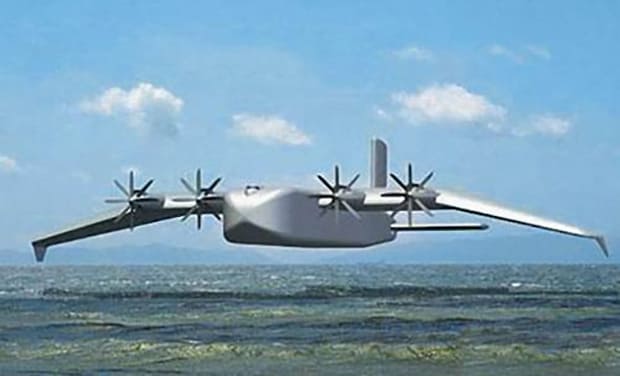 Transport ekranoplan "Pelican" by "Boeing"
Transport ekranoplan "Pelican" by "Boeing"
The accumulated experience of work on ekranoplanes allowed in 1998 g. enter the "Rules for the Classification and Construction of light type A WIG" Russian Maritime Register of Shipping, Based on these rules at the end of 2002 g. - "Interim Guidelines on safety of WIG 'International Maritime Organization, and "Rules for Classification and Construction WIG" Russian River Register. Currently under construction is quite a lot of variety WIG, both by enthusiastic amateurs, and on the respective companies. Some of them (eg, WIG "Aquaglide") already produced in small batches and have good commercial prospects. The Russian design, serial production and promotion of ekranoplanes to the world market are carried out by design bureaus and enterprises, included in the financial and industrial group "High-speed fleet".
Combat ekranoplanes
Now let's move on to the issue of the combat use of ekranoplanes. The USSR has an indisputable priority in this area., in which two types of combat ekranoplanes were created. The concept of their combat use was developed., which took into account all the advantages of this aircraft class. The advantages of the airfoil may include their high speed as compared with vessels, invulnerability to weapons minnotorpednogo, high compared to aircraft weight (a, Consequently, range, combat load, seaworthiness, firepower and survivability), low radar signature and low vulnerability to air defense systems.
The difficulties of radar detection of this class of aircraft are due to the fact, that the entire flight takes place at a height of several meters above the water surface, and small missiles vulnerability from "earth-to-air" and "air-to-air" is the difficulty of gripping the purposes of this class as the thermal, and radar homing heads.
The concept of the combat use of ekranoplanes assumed four main directions:
- troop-carrier - given their high mobility and amphibiousness, to be used for landing WIG capture bridgeheads, which further landing troops was to be made with common assault ships;
- search and rescue - to rescue ships in distress in the ocean. In this case, because of its speed and range WIG can come to a designated area almost anywhere in the world's oceans much faster rescue ships. Seaworthiness and high payload allow them to carry out rescue and providing the necessary assistance directly on the high seas more excitement, what it can do seaplanes;
- shock - to be used to combat WIG aircraft carrier potential enemy compounds. At the same time it takes into account their high speed, range, firepower, low visibility and difficulty lesion WIG air defenses;
- patrol and antisubmarine - monitoring and control of enemy submarines, as well as the interception based on their ballistic missiles in the boost phase of their trajectory;
Unique long-term experience in the use of WIG confirmed the main provisions of this concept. During the operation confirmed the high efficiency of this class of devices.
To be continued…










